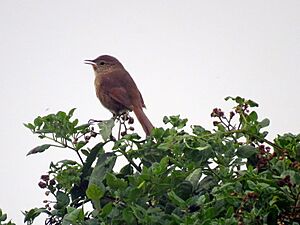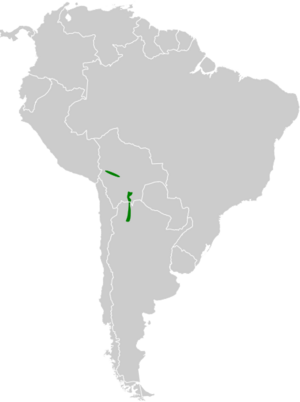Maquis canastero facts for kids
Quick facts for kids Maquis canastero |
|
|---|---|
 |
|
| Conservation status | |
| Scientific classification | |
| Genus: |
Asthenes
|
| Species: |
heterura
|
 |
|
The maquis canastero, also called the Andean canastero, is a small bird. Its scientific name is Asthenes heterura. It is part of the ovenbird family called Furnariidae. You can find this bird living in Argentina and Bolivia.
Contents
About the Maquis Canastero
The maquis canastero is a unique type of bird. Scientists have studied how it relates to other birds. Sometimes, they thought it was a subspecies of the canyon canastero. Other times, they believed it was the same species as the rusty-fronted canastero. It might be most closely related to the very similar sharp-billed canastero.
What Does It Look Like?
The maquis canastero is about 16 to 17 centimeters (6 to 7 inches) long. It weighs around 13 to 14 grams (0.46 to 0.49 ounces). Both male and female birds have the same colors.
Its face is light brownish. It has a pale, yellowish-brown stripe above its eye. This stripe is called a supercilium. There is also a ring around its eye. The top of its head, back, and rump are a rich brown color. The feathers covering its upper tail are chestnut.
Its wings are mostly reddish-brown. The tips of its flight feathers are dark. The two inner pairs of tail feathers are longer than the others. They are a dusky reddish-brown. The rest of the tail feathers are chestnut-reddish-brown and get shorter.
Its chin and upper throat are a pale orange-reddish-brown. Its chest and belly are grayish-yellowish-brown. The sides of its body are browner. Its flanks and undertail coverts are a yellowish-brown color. The bird's eyes are brown. Its upper beak is black, and its lower beak is pinkish with a black tip. Its legs and feet are dark gray to dark olive-gray.
Where Does It Live?
The maquis canastero lives on the eastern side of the Andes mountains. Some experts say it lives in Bolivia and Argentina. It seems to live in separate areas. One group lives in northern Bolivia, in the La Paz and Cochabamba regions. Another group lives in northwestern Argentina. This includes the Jujuy, Salta, and Tucumán provinces. There have been sightings in Bolivian areas between these two main groups.
This bird lives in different types of places. These include dry or semi-wet mountain scrublands. It also lives in scrublands with open forests of Alnus and Polylepis trees. You can also find it in mountain grasslands with scattered bushes. It even lives in farm areas with bushes and hedges. It usually lives at high elevations. This is typically between 3,000 and 4,200 meters (9,800 to 13,800 feet) high. Sometimes, it can be found as low as 2,500 meters (8,200 feet).
Behavior
Movement
The maquis canastero stays in the same area all year long. It does not migrate.
Feeding Habits
This bird eats arthropods, which are creatures like insects and spiders. It usually looks for food alone or in pairs. Sometimes, it joins groups of different bird species feeding together. It finds its food by picking it off the ground. It might also find food on low plants.
Reproduction and Life Cycle
Scientists do not know much about how the maquis canastero breeds.
What Sounds Does It Make?
The maquis canastero's song is a fast series of squeaky notes. These notes get faster and faster. It also sings a longer song. This song is a series of high, squeaky, and strained notes. They vary in length and also get faster and go down in pitch. Its call sounds like a steady trill, like "tuírrrr".
Conservation Status
The IUCN (International Union for Conservation of Nature) first listed the maquis canastero as Vulnerable. Then, in 2004, it was called Threatened. Since 2020, it has been listed as being of Least Concern. This means it is not currently at high risk of extinction.
The bird lives across a large area. Its population is estimated to be between 10,000 and 20,000 adult birds. However, this number is thought to be decreasing. The main threat to this bird is the loss of Polylepis woodlands. These forests are cut down for wood and firewood. They are also cleared for farming and grazing animals. Even so, the maquis canastero seems to handle some changes to its habitat. It can live in cattle pastures and on cultivated land. It is considered fairly common to uncommon. However, it is probably often missed by people.


